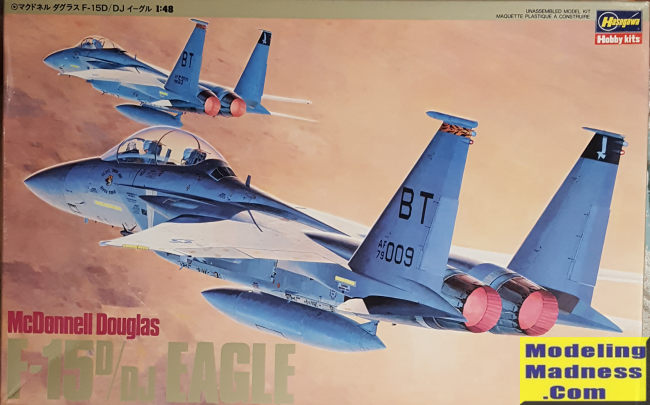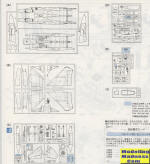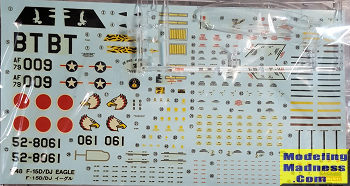
Hasegawa 1/48 F-15D/DJ Eagle
| KIT #: | P11 |
| PRICE: | 2400 yen when new |
| DECALS: | Two options |
| REVIEWER: | Scott Van Aken |
| NOTES: | 1986 release |

| HISTORY |
Based on the results of air to air combat in Vietnam, the USAF decided that its next fighter/interceptor would learn from those experiences. So in addition to having speed and the same weapons carrying capability as the F-4, it would also have an internal gun and the ability to dog fight with the best of them. Another requirement was dual engines for safety and the additional thrust it provided.
The USAF also required there to be a two seat conversion trainer to allow pilots new to the aircraft to gain some experience with a qualified pilot before moving on to the standard single seat planes. These planes retained all of the same equipment and capabilities as the single seat F-15s, so that they could participate in battle if they were so needed. The single seat F-15 has never been equipped to be a fighter-bomber, but the two seat versions were developed into the very successful F-15E Strike Eagle, versions of which are still being manufactured.
| THE KIT |
 According
to Scalemates, the first 1/48 F-15 that Hasegawa released was the Strike Eagle a
year before this one. Of course, it is not a production plane, but a standard
F-15B with fast packs and additional bomb racks. However, that kit spawned
dozens of limited edition reboxings of both USAF and JASDF aircraft, the most
recent being 2017. The kit has an acceptable interior that has nicely raised
detail for the instrument panel. There are also a pair of crew figures if you
like to use those. It would benefit from the greater detail of resin ejection
seats.
According
to Scalemates, the first 1/48 F-15 that Hasegawa released was the Strike Eagle a
year before this one. Of course, it is not a production plane, but a standard
F-15B with fast packs and additional bomb racks. However, that kit spawned
dozens of limited edition reboxings of both USAF and JASDF aircraft, the most
recent being 2017. The kit has an acceptable interior that has nicely raised
detail for the instrument panel. There are also a pair of crew figures if you
like to use those. It would benefit from the greater detail of resin ejection
seats.
With the cockpit built and the nose gear well attached to it, it can be inserted in the nose halves. Like most F-15 kits, it has a separate forward section so that both the single and twin seat versions can be done. The aft section is split horizontally. It is then that the intakes and exhaust are built up and installed. The intake trunking goes right up to the first compressor stage. Wings are next with the outer pylon holes needing to be opened if you plan to use them. These and the fins along with the stabs are next. Hasegawa has made the starboard fin so that you can install either the large balance used by USAF planes or the small one used by other nations.
Attention then turns to the sturdy landing gear. Those gear doors normally closed on the ground are molded shut, which eliminates some possible gap issues. Moving to the top, one can pose the speed brake open, but that is generally closed on the ground, except when taxiing past crowds at air shows. Canopy can be posed open if one desires.
 The last
things are the stuff under wings. This includes the pylons and three fuel tanks.
This kit includes Sidewinders and Sparrow missiles so no need to purchase the
weapons set for this one.
The last
things are the stuff under wings. This includes the pylons and three fuel tanks.
This kit includes Sidewinders and Sparrow missiles so no need to purchase the
weapons set for this one.
Instructions provide two markings options, both in the early compass ghost grey scheme. The USAF plane is with the 53rd TFS out of Bitburg, Germany. The Japanese option is with 204 Squadron. The decals are nicely printed, but I'd have to say they are probably past their 'use by' date as they are starting to yellow. Fortunately, there are many aftermarket options out there.
| CONCLUSIONS |
Just looking at it, the kit appears to be a pretty trouble-free build. It has been superceded in terms of detail and small parts by kits from GWH and 'perhaps' by Academy. This one does have the turkey feathers burner petals, items that were removed from USAF planes in the late 80s and early 90 to simplify maintenance.
February 2023
Copyright ModelingMadness.com. All rights reserved. No
reproduction in part or in whole without express permission from the editor.
If you would like your product reviewed fairly and fairly
quickly, please
contact
the editor or see other details in the
Note to
Contributors.